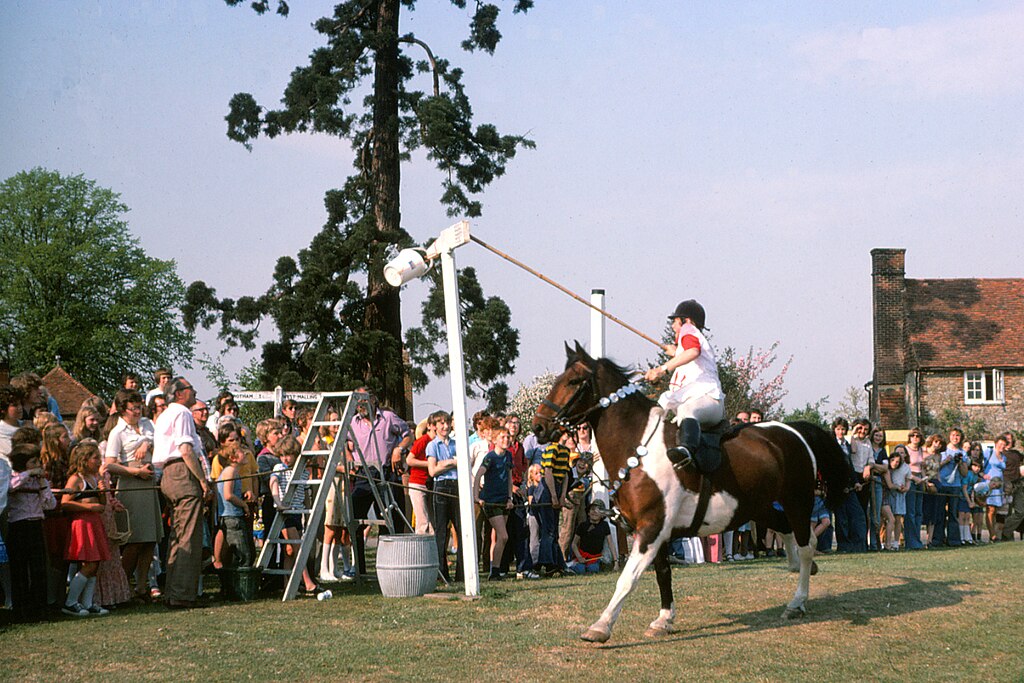Sports involve activities that can enhance people’s skills and abilities. Aside from that, they are also great form of entertainment and can be pastime activities as well. Sports are also beneficial to our health because they can be used as exercises. In the present time, many sports are played all over the world and international competitions are being held. But it was different in the ancient times.
Back in the ancient times, each town had their own kind of sports which served as their pastime. However, unlike the sports we have today, some of the games they played were bizarre which are now mostly forgotten. Well, maybe it’s because no one in the present time would like to try playing the games they had back then. If you’re curious about them, here are some of the bizarre ancient sports.
1. Episkyros
This was just a simple ball game that was played by the ancient Greeks. In fact, it was not created for athletes but for everybody else instead such as old people, children, and women.
The sport was played with two teams with equal members who stood opposite each other. A line called the skuros was drawn between the two teams, and two more lines were drawn behind each team. One team would throw the ball over the other and would try to advance as their opponents recovered. When the other team grab the ball, they would throw it back trying to make up any lost ground and would push the other players back. The first team that would completely push the other side over the line would be the winner.
This was a similar sport to modern rugby or American football. It was popular in Sparta where children and women were expected to take part in it. It was also the game which inspired the creation of harpastum which was more physical.
Every year at the city festival, this ancient ball game is played. This game permitted players to make full contact with each other, much like current rugby or football. Because it was practiced in ancient Sparta, anticipate aggression in this sport.
2. Cock Shying
This was a popular sport in England back in the 18th century. It was also known as cock throwing. In this sport, people threw things, specifically weighted sticks called “coksteles”, at the rooster until it was killed. This sport was associated with Shrove Tuesday or Pancake Day which is celebrated at the last day before Lent. During the ancient times, cock-shying was frequently practiced at pubs just for fun.
The rooster would be taken outside and tied to a post. People would then throw their coksteles at it. When someone hit the rooster and it did not die, he was allowed to grab the shocked bird before it recovered. If he succeeded, he could take home the rooster.
This sport was banned in 1660 in Bristol, the day before Shrove Tuesday. However, the following day, there was a riot and in protest, people threw dogs and cats at the mayor’s house.
As people’s moral and social norms changed, this brutal pastime was forgotten. Animal welfare was carefully enforced as a result of these reforms.
3. Quintain
Jousting tournaments are very popular back in the ancient times. However, to be able for a knight to join a jousting tournament, he would need to train first and that tranining was called quintain.
In this sport, instead of two knights charging at each other, one knight would charge at a quintain, which was a stationary target. This target was usually a shield that was balanced on a pole which had a counterweight at the other end.
When the quintain was hit, it would spin. When it was shot accurately, it would spin at a maximum speed and the knight’s skill would be considered good. However, if the hit was slow or incorrect, it could spin the weight in time to hit the rider and knock him off his horse. Since this sport was some kind of a training, everyone was free to watch as well as to participate.
In addition to training the knights and providing entertainment for the general audience, this medieval sport was developed to test the horsemen’s agility. Moreover, the aim of the game is to score a successful shot to defeat the quintain itself.
4. Equestrian Long Jump
There are some sports which are created by combing two existing concepts. One of those was the equestrian long jump which came from human long jump and horse racing. Its concept sounded exciting and this sport was even featured in the 1900 Summer Olympics in Paris. However, it failed to make an impression that’s why it was no longer played today.
The winning leap was only 6.1 meters or 20 feet, and people back in those days were expecting an inhuman display of athletic skill. It’s no match if you will compare it with the current world record for a human long jump which is 8.95 meters or 29.4 feet.
It was remarkable to see such an astounding demonstration of the horse’s strength and agility, with the rider of course on those days. There are still usual equestrian sports, despite the fact that they are not currently featured in the Olympics. Moreover, show jumping is still done in several horse shows and rider competitions.
5. Barking Off Squirrels
This sport was a type of squirrel hunting in the late 18th and 19th century in America. It started in the backwoods of Kentucky and was popularized by Daniel Boone who was a renowned frontiersman.
The goal of this sport was to hunt squirrels without shooting them. The players would shoot the bark right below the squirrels instead. The impact of this was strong enough to destroy the bark and create a blast that was powerful enough to kill the squirrels.
Even while squirrels could seem hazardous to humans and destructive to property since they may spread rabies, this type of “sport” is really odd. n this bloodless sport, in addition to the squirrels who would be killed by the explosion, there would also be collateral damage to the tree where they would continue to fire, as the bullet would injure it.
6. Turtle Racing
Turtle racing is still practiced in the present time but it was done differently back in the ancient times. If it is considered as a fun game for children today, that was not the case 100 years ago.
In the ancient times, giant turtles were used in a genuine straight-line race. There were a lot of people who watched these races just like in a horse race. There were even small children who rode the turtles like jockeys.
Giant turtle removal from its natural environment may result in the animal’s stress and eventual death. And it would be terrible to ride on the trutles’ backs. Well, many improvements were made to make this suitable for everyone’s enjoyment because of concerns for animal welfare and public awareness.
7. Eel Pulling
This sport was popular in Netherlands in the 19th century. It had two types and one was the classic tug of war. But instead of pulling a rope, it was replaced with a live eel. It was even soaped to make it more slippery.
The other type of this sport involved hanging the eel from a line dangling over a canal. The players would jump and take down the eel while passing through the canal in a boat. This was the more popular version of eel pulling.
The largest eel pulling hot spot was located in Amsterdam. People played it even when it was outlawed. Banning the game had triggered the Eel Riot of 1886 which ended up in 26 deaths and 100 injuries.
It was concluded that during the three days that this disturbance lasted, rioters blocked traffic, destroyed properties, and engaged in violent conflict with law enforcement. The competitors’ frustration with not receiving the sport’s prize, a delectable and decent dinner, is the primary reason of the incident.
8. Stoolball
The origins of this sport can be traced back to the 14th century in Sussex, and it still being played occasionally in small areas of southeast England. It’s thought that milkmades used the stools as a wicket when the game first began 500 years ago. For some historians, it could be the ancestor of cricket and baseball. It was also considered by some as the first bat-and-ball game that was played in North America.
In this sport, the players would hit a ball using a bat and then run between stools to score. The bat they used was a wooden paddle that had a short handle and was oval-shaped. The sport became popular that in 1927, there were over 1,000 stoolball clubs all over the world.
9. Dwile Flonking
For some enthusiast, this sport can be traced back during the Suffolk harvests which was 400 years ago. However, this traditional pub sport has been banned in several places because it had violated health and safety regulations. Since this odd English sport is a drinking game, it contributes to several alcohol-related issues like alcoholism, heart issues, and other health issues. [1]
This sport involved lots of drinking, as well as two teams trying to fling a beer-soaked cloth which was called dwile, at each other’s head. One player holds a pole with the dwile on it and the other team dances in a circle around him. His goal was to hit one of the players with the dwile. If he missed, the opposing team would form a straight line where he must down a pot of beer before the dwile gets passed from player to player down the line.
10. Fox Tossing
This sport originated in the 17th century. Back in those times, Europe’s aristocracy were flinging foxes into the air. This sport was exclusive for the upper classes and was usually held at big events.
The sport was played in pairs. Each member would hold the end of a sling lying on the ground. Then, foxes would be let loose in the playing field. When a fox ran over the sling, the players would pull the sling hard for the fox to be thrown into the air. The pair who would be able to toss the fox the highest was the winner.
When foxes where not available, other critters were used such as hares, badgers, wild boars, wild cats, and even wolves. It was a really dangerous sport because it involved frightened animals that could attack the players. This sport was completely outlawed in the early 19th century due to its danger and barbaric nature.
These are some of the bizarre sports that were played in the ancient times. Some of them were indeed out of this world and no one in the present time would dare try them because of the danger they come with. But these sports had indeed helped ancient people in practicing some of their skills.
Reference
[1] Risky Drinking. Rethink Your Drinking.ca Accessed on: February 26, 2023



